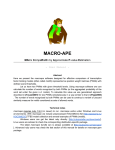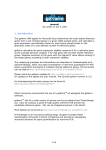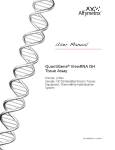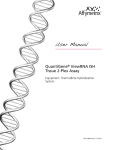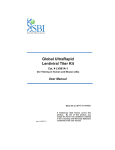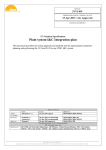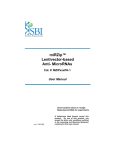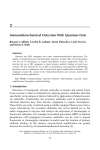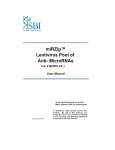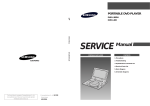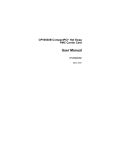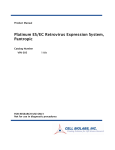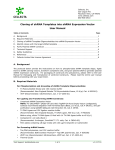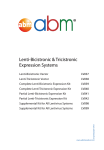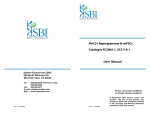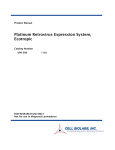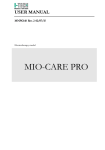Download Neuronal Transdifferentiation Factor User Manual
Transcript
Mouse Neuronal Differentiation Factor Expression Lentivectors Cat. #TD2xxx User Manual Store at -20ºC ver. 1-081211 A limited-use label license covers this product. By use of this product, you accept the terms and conditions outlined in the Licensing and Warranty Statement contained in this user manual. Mouse Neuronal Differentiation Factor Expression Lentivectors Cat. # TD2xxx Contents I. Introduction and Background ..................................................2 A. Overview .............................................................................2 B. Expression Lentivectors offered by SBI ..............................3 C. Safety Guidelines ................................................................4 II. Protocols .................................................................................6 Necessary Materials ....................................................................6 Packaging the lentiviruses...........................................................6 D. III. Induction Protocol ...............................................................7 Validation Data ....................................................................8 Sequence Validation Data ...........................................................8 mRNA Expression Data ..............................................................8 E. Functional Validation Data ..................................................9 IV. Related Products ................................................................9 V. Appendix ...............................................................................10 Map and Features .....................................................................10 F. Composing N2B27 medium ..............................................11 G. Technical Support .............................................................11 VI. References ........................................................................12 VII. Licensing and Warranty ....................................................12 888-266-5066 (Toll Free) 650-968-2200 (outside US) Page 1 System Biosciences (SBI) I. User Manual Introduction and Background A. Overview SBI offers lentiviral expression vectors of five mouse neuronal differentiation factors, Brn2, Myt1l, Zic1, Olig2, and Ascl1. These five factors have been successfully used in reprogramming both mouse embryonic fibroblasts (MEFs) and tail fibroblasts directly to neurons (iN) (Wernig et al.). These "5-factor" iNs expressed neuronal markers MAP2, NeuN, and synapsin, and demonstrated functional membrane properties similar to neurons. Cells were positive for vGLUT-1 and GABA, formed functional synapses, were able to produce action potentials and contained functional voltage-dependent and ligand-gated ion channels. Generation of iN in this fashion has an advantage of avoiding tumorigenic pluripotent cells and may provide a platform for more efficient disease modeling and drug discovery. Page 2 ver. 1-081211 www.systembio.com Mouse Neuronal Differentiation Factor Expression Lentivectors Cat. # TD2xxx B. Expression Lentivectors offered by SBI The five mouse neuron differentiation factors are cloned into SBI’s CD500B-1 HIV-based expression lentivector (Appendix A). Expression is driven by the CMV promoter and the transcript is stabilized by the WPRE element. The vector contains AmpR for selection in E. coli cells. The neuron differentiation factors in lentivector are available individually and collectively as a set of five or as a set of three that was shown to be sufficient and most effective in conversion by Wernig et al. For a full listing of all of the neuron differentiation factors available, please see the SBI website at: http://www.systembio.com/stem-cell-research/transdifferentiationfactors/ordering 888-266-5066 (Toll Free) 650-968-2200 (outside US) Page 3 System Biosciences (SBI) User Manual C. Safety Guidelines SBI’s expression lentivectors together with the pPACK packaging plasmids comprise the third-generation lentiviral expression system. The HIV-based lentivectors are based on the vectors developed for gene therapy applications by Dr. J. G. Sodroski (U.S. patents # 5,665,577 and # 5,981,276). HIV-based lentivector systems are designed to maximize their biosafety features, which include: • • • • • A deletion in the enhancer of the U3 region of 3’ΔLTR ensures self-inactivation of the lentiviral construct after transduction and integration into genomic DNA of the target cells. The RSV promoter (in HIV-based vectors) and CMV promoter (in FIV-based vectors) upstream of 5’LTR in the lentivector allow efficient Tat-independent production of viral RNA, reducing the number of genes from HIV-1 that is used in this system. Number of lentiviral genes necessary for packaging, replication and transduction is reduced to three (gag, pol, rev), and the corresponding proteins are expressed from different plasmids (for HIV-based packaging plasmids) lacking packaging signals and share no significant homology to any of the expression lentivectors, pVSV-G expression vector, or any other vector, to prevent generation of recombinant replication-competent virus. None of the HIV-1 genes (gag, pol, rev) will be present in the packaged viral genome, as they are expressed from packaging plasmids lacking packaging signal—therefore, the lentiviral particles generated are replicationincompetent. Pseudoviral particles will carry only a copy of your expression construct. Despite the above safety features, use of SBI’s lentivectors falls within NIH Biosafety Level 2 criteria due to the potential biohazard Page 4 ver. 1-081211 www.systembio.com Mouse Neuronal Differentiation Factor Expression Lentivectors Cat. # TD2xxx risk of possible recombination with endogenous viral sequences to form self-replicating virus, or the possibility of insertional mutagenesis. For a description of laboratory biosafety level criteria, consult the Centers for Disease Control Office of Health and Safety Web site at http://www.cdc.gov/od/ohs/biosfty/bmbl4/bmbl4s3.htm. It is also important to check with the health and safety guidelines at your institution regarding the use of lentiviruses and always follow standard microbiological practices, which include: • • • • • • Wear gloves and lab coat all the time when conducting the procedure. Always work with pseudoviral particles in a Class II laminar flow hood. All procedures are performed carefully to minimize the creation of splashes or aerosols. Work surfaces are decontaminated at least once a day and after any spill of viable material. All cultures, stocks, and other regulated wastes are decontaminated before disposal by an approved decontamination method such as autoclaving. Materials to be decontaminated outside of the immediate laboratory area are to be placed in a durable, leakproof, properly marked (biohazard, infectious waste) container and sealed for transportation from the laboratory. Please keep in mind that pCDH vectors are integrated into genomic DNA and could have a risk of insertional mutagenesis. 888-266-5066 (Toll Free) 650-968-2200 (outside US) Page 5 System Biosciences (SBI) II. User Manual Protocols A. Necessary Materials • • • • • • A midiprep or maxiprep kit Competent E. coli cells pPACK™ packaging plasmid mix (cat#LV500A-1) Transfection reagent such as SBI’s PureFection™ (cat#LV750A-1) Infection reagent such as SBI’s TransDux™ (cat#LV850A1) A virus titering kit B. Packaging the lentiviruses Package the lentiviruses following SBI’s guide “Lentivector Expression Systems: Guide to Packaging and Transduction of Target Cells”. SBI offers a complete line of tools for efficient virus packaging, concentration, titering, and subsequent transduction (see Related Products in Section III). Below is an outline of this procedure. Please reference the appropriate manuals for detailed steps. 1. Transform individual plasmid DNA into competent E.coli cells, such as Invitrogen®’s Stbl2 or Stbl3 using standard transformation procedure. 2. Performing a midiprep or maxiprep of the lentivectors. Propagate E. coli cells, at 30°C to reduce the chance of recombination, if competent cells such as Top 10 and OmniMax were used for transformation. 3. After sufficient DNA has been harvested, transfect plasmid DNA individually in producing cell line with SBI’s pPACK™ (which contains the necessary proteins to complete the packaging of the lentiviral particles) and a transfection reagent such as SBI’s PureFection®. 4. Harvest and concentrate the lentiviral particles from the transfection media after 48-72 hours. This is easily done with SBI’s PEG-it™ solution (cat#LV810A-1) 5. Determine the IFU/mL of the viruses using a titering kit, such as SBI’s Global UltraRapid Lentivirual Titer Kit™ (cat#LV961A-1). Page 6 ver. 1-081211 www.systembio.com Mouse Neuronal Differentiation Factor Expression Lentivectors Cat. # TD2xxx C.Induction Protocol The following protocol has been optimized for MEF cells according to the method described in Wernig et. al. 1. In a 6-well plate (9.6 cm2/well), seed 1-2e5 MEF cells per well and incubate overnight in MEF media (DMEM + 10% FBS) 2. The next day, aspirate MEF medium and add 2 mL of pre-warmed MEF media, and incubate for two hours. Infect the MEF cells with the lentivirus pool containing 5 transcription factors each at MOI of 10 supplemented with 4ul of TransDux (cat# LV850A-1). 3. The next day, repeat step 2. 4. The next day aspirate MEF media and add 2 mL of fresh, pre-warmed MEF medium and incubate overnight. 5. The next day, aspirate MEF media, wash the cells with pre-warmed N2B27 media twice (composition can be found in Appendix B) and add 2 mL of fresh, prewarmed N2B27 media. Incubate overnight. 6. Refresh the N2B27 media every other day until neuronal cells are observed (observation may be difficult in high cell density). Splitting the cells is not recommended. Cells can be stained for a neuronal marker such as MAP2. 888-266-5066 (Toll Free) 650-968-2200 (outside US) Page 7 System Biosciences (SBI) III. User Manual Validation Data A. Sequence Validation Data All constructs have been sequence verified. B. mRNA Expression Data Shown below are the mRNA expression validation data of the five differentiation factors and GAPD as internal control. 293T and MEF cells were infected with a five-factor virus pool and collected 3 days after infection for RNA extraction. PCR was then performed using cDNA generated from the normalized RNA extract using gene-specific primers. Page 8 ver. 1-081211 www.systembio.com Mouse Neuronal Differentiation Factor Expression Lentivectors Cat. # TD2xxx C. Functional Validation Data In the images below, MEF induced neuronal cells display complex neuronal morphology (left) and express Tuj1 (right) 12 days after infection with five transcription factors. IV. ARelated Products The following related www.systembio.com • • • • • • B products are available at Producer Cell Line: SBI’s 293 TN cell line produces high titer lentivirus Virus Packaging Systems: pPACK™ packaging plasmid mix for optimized for lentivirus production Transfection reagent: PureFection™ transfers DNA and siRNAs to cells with high efficiency using a nanotechnology-based reagent. Virus concentration: Easily concentrate lentiviruses with PEG-it™ virus precipitation solution Virus Transduction: Easily transduce your target cells with TransDux™ Virus titering: Accurate and easy qPCR measurement of lentiviral titers with the Global UltraRapid™ Lentiviral Titer Kit. 888-266-5066 (Toll Free) 650-968-2200 (outside US) Page 9 System Biosciences (SBI) V. User Manual Appendix A. Map and Features Map of the expression lentivectors. Neuron differentiation factors (mAscl1, mBrn2, mMyt1l, mOlig2, and mZic1) are in the position indicated as “iN Factor”. The table below lists the features and functions of the lentiviral constructs. Feature RSV-5’ LTR gag RRe cPPT CMV Kozak sequence Page 10 Function Hybrid RSV promoter-R/U5 long terminal repeat; required for viral packaging and transcription Packaging signal Rev response element binds gag and involved in packaging of viral transcripts Central polypurine tract (includes DNA Flap region) involved in nuclear translocation and integration of transduced viral genome Human cytomegalovirus (CMV)--constitutive promoter for transcription Allows ribosomes to recognize the initiator codon ver. 1-081211 www.systembio.com Mouse Neuronal Differentiation Factor Expression Lentivectors Cat. # TD2xxx WPRE Posttranscriptional regulatory element which enhances the stability of the viral transcripts 3’ ΔLTR Required for viral reverse transcription; selfinactivating 3' LTR with deletion in U3 region (ΔU3) prevents formation of replication-competent viral particles after integration into genomic DNA SV40 Poly-A Transcription termination and polyadenylation SV40 Ori Allows for episomal replication of plasmid in eukaryotic cells pUC ORI (C) Allows for high-copy replication in E. col AmpR (C) Ampicillin resistant gene for selection of the plasmid in E. coli *The notation (C) refers to the complementary strand. B. Composing N2B27 medium Add 0.5 ml of N2 supplement to 49.5 ml of DMEM/F12 medium. Add 1 ml of B27 supplement to 49 ml of Neurobasal medium. Mix together and filter using a 0.22µm filter. Store at 4°C for up to 2 weeks. C. Technical Support For additional information or technical assistance, please call or email us at: System Biosciences (SBI) 265 N. Whisman Rd. Mountain View, CA 94043 Phone: (650) 968-2200 (888) 266-5066 (Toll Free) Fax: (650) 968-2277 E-mail: General Information: [email protected] Technical Support: [email protected] Ordering Information: [email protected] 888-266-5066 (Toll Free) 650-968-2200 (outside US) Page 11 System Biosciences (SBI) VI. User Manual References Wernig, M, et al. Direct Conversion of fibroblasts to functional neurons by defined factors. Nature 463, 1035-1041 (2010). VII. Licensing and Warranty Use of the Mouse Neuronal Differentiation Factor Expression Lentivectors (i.e., the “Product”) is subject to the following terms and conditions. If the terms and conditions are not acceptable, return all components of the Product to System Biosciences (SBI) within 7 calendar days. Purchase and use of any part of the Product constitutes acceptance of the above terms. The purchaser of the Product is granted a limited license to use the Product under the following terms and conditions: The Product shall be used by the purchaser for internal research purposes only. The Product is expressly not designed, intended, or warranted for use in humans or for therapeutic or diagnostic use. The Product may not be resold, modified for resale, or used to manufacture commercial products without prior written consent of SBI. This Product should be used in accordance with the NIH guidelines developed for recombinant DNA and genetic research. ** This Product shall be used by the purchaser for internal research purposes only and distribution is strictly prohibited without written permission by System Biosciences HIV Vector System This product is for non-clinical research use only. Use of this Product to produce products for resale or for any diagnostic, therapeutic, clinical, veterinary, or food purpose is prohibited. In order to obtain a license to use this Product for these commercial purposes, contact the Office of Research and Technology Ventures at the Dana-Farber Cancer Institute, Inc. in Boston, Massachusetts, USA. This Product or the use of this Product is covered by U.S. Patents Nos. 5,665,577 and 5,981,276 owned by the Dana-Farber Cancer Institute, Inc. Page 12 ver. 1-081211 www.systembio.com Mouse Neuronal Differentiation Factor Expression Lentivectors Cat. # TD2xxx WPRE Technology System Biosciences (SBI) has a license to sell the Product containing WPRE, under the terms described below. Any use of the WPRE outside of SBI’s Product or the Products’ intended use, requires a license as detailed below. Before using the Product containing WPRE, please read the following license agreement. If you do not agree to be bound by its terms, contact SBI within 10 days for authorization to return the unused Product containing WPRE and to receive a full credit. The WPRE technology is covered by patents issued to The Salk Institute for Biological Studies. SBI grants you a non-exclusive license to use the enclosed Product containing WPRE in its entirety for its intended use. The Product containing WPRE is being transferred to you in furtherance of, and reliance on, such license. Any use of WPRE outside of SBI’s Product or the Product’s intended use, requires a license from the Salk Institute for Biological Studies. This license agreement is effective until terminated. You may terminate it at any time by destroying all Products containing WPRE in your control. It will also terminate automatically if you fail to comply with the terms and conditions of the license agreement. You shall, upon termination of the license agreement, destroy all Products containing WPRE in you control, and so notify SBI in writing. This License shall be governed in its interpretation and enforcement by the laws of California. Contact for WPRE Licensing: The Salk Institute for Biological Studies, 10010 North Torrey Pines Road, La Jolla, CA 92037; Attn: Office for Technology Management; Phone: (858) 435-4100 extension 1275; Fax: (858) 450-0509. Wernig’s Neuron-specific Transcription Factors SBI has a license from Stanford University to sell Wernig’s transcription factors that are covered under US patent application, 888-266-5066 (Toll Free) 650-968-2200 (outside US) Page 13 System Biosciences (SBI) User Manual Serial Number 61/336,309, filed January 21, 2010, any foreign patent application corresponding thereto , and any divisional, continuation, or reexamination application, and each patent that issues from any of these patent applications. CMV Promoter The CMV promoter is covered under U.S. Patents 5,168,062 and 5,385,839 and its use is permitted for research purposes only. Any other use of the CMV promoter requires a license from the University of Iowa Research Foundation, 214 Technology Innovation Center, Iowa City, IA 52242. Limited Warranty SBI warrants that the Product meets the specifications described in the accompanying Product Analysis Certificate. If it is proven to the satisfaction of SBI that the Product fails to meet these specifications, SBI will replace the Product or provide the purchaser with a refund. This limited warranty shall not extend to anyone other than the original purchaser of the Product. Notice of nonconforming products must be made to SBI within 30 days of receipt of the Product. SBI’s liability is expressly limited to replacement of Product or a refund limited to the actual purchase price. SBI’s liability does not extend to any damages arising from use or improper use of the Product, or losses associated with the use of additional materials or reagents. This limited warranty is the sole and exclusive warranty. SBI does not provide any other warranties of any kind, expressed or implied, including the merchantability or fitness of the Product for a particular purpose. SBI is committed to providing our customers with high-quality products. If you should have any questions or concerns about any SBI products, please contact us at (888) 266-5066. © 2011 System Biosciences (SBI), All Rights Reserved Page 14 ver. 1-081211 www.systembio.com















